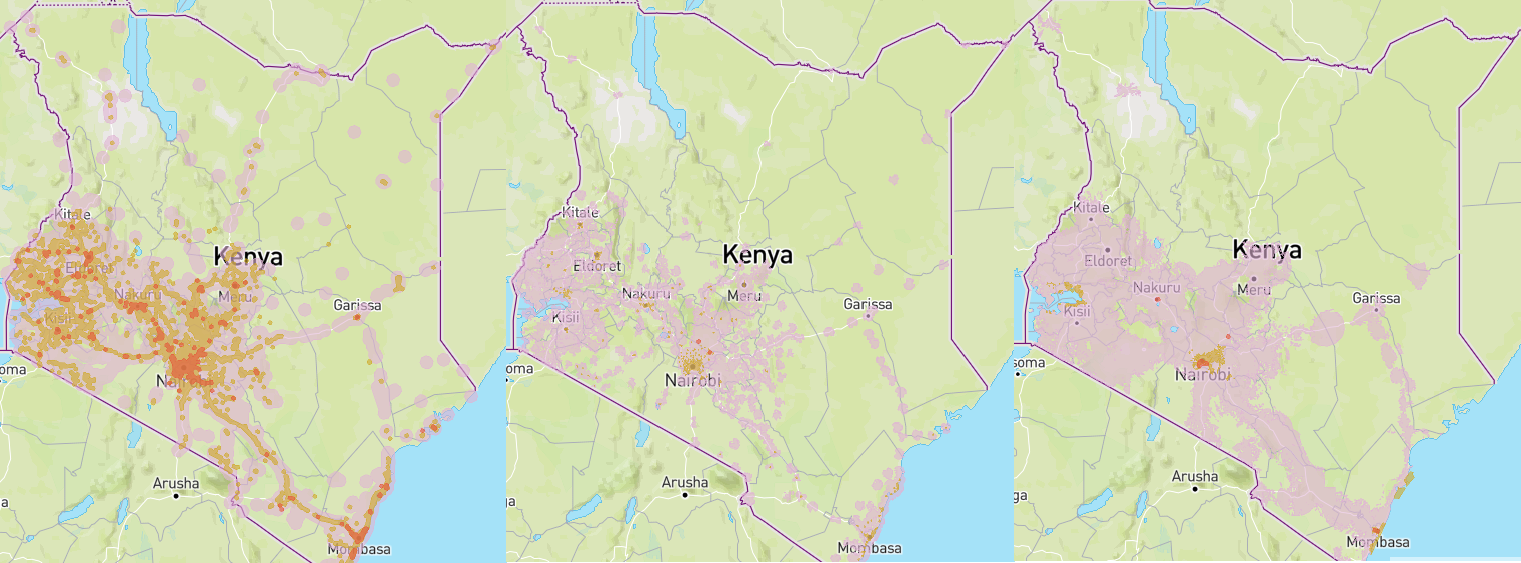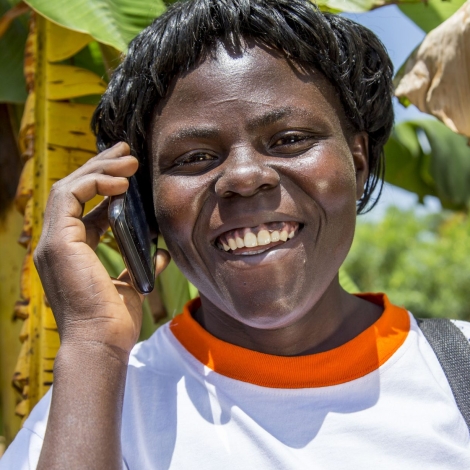If you ask people in Nairobi where they might like to live if they didn’t have to worry about a commute to work, the answer is nearly unanimous: the suburbs. The suburbs, they say, lie just close enough to the city’s amenities while avoiding its traffic, high costs and pollution. When I suggest rural Kenya as an option, very few people respond positively. Why? Rural communities often lack reliable electricity, Internet access, good schools and healthcare facilities.
Social innovators should take notice. Missing necessities can deter people from moving to rural Kenya, and their absence also presents a host of considerations for digital technologies designed to operate in those areas. In spite of that, rural Kenya is home to 68.9 percent of the Kenyan population with the Arid and Semi-Arid Lands alone occupying almost 80 percent of the total landmass. This large size and population make them key to the economic growth of the country and it is imperative that they do not miss out on the digital revolution.
Rural-Urban Divide
Rural areas in Kenya face a number of unique development challenges that affect the use of digital technologies. The Kenya Economic Update by the World Bank notes that while 44% of the urban population have access to the internet, only 17% of people in rural areas have access to the same. What works in urban areas may not necessarily work in rural areas.This is the reason why, at the moment, we see more people working on technologies that are more suitable for urban areas. But understanding the issues may encourage more product developers to target rural areas. Here I’ll describe three main challenges that innovators will face in rural Kenya.
Infrastructure
Infrastructure remains one of the greatest challenges in rural Kenya. From innovation hubs, learning institutions, Internet services, mobile networks, and access to grid power, people in rural areas have less access than residents in urban areas. Deficiencies in services cascade from key absences. For example, the absence of power means it is harder for telcos to set up mobile networks, and the absence of mobile networks means that fewer people acquire mobile devices.
Even where the infrastructure is available, the quality may not be sufficient. While 77 percent of major towns in Kenya are covered with a Safaricom 4G network, the total 4G population coverage in Kenya is only 57 percent, and the majority of places not covered are rural. From the map below, it is notable that the area with the least coverage is rural Kenya, and the 4G coverage is quite low.

This network coverage map shows, from left to right, Safaricom, Airtel, Telekom (pink-GSM, yellow-3G, orange-LTE).
Patrick Sampao who has experience deploying digital solutions in rural areas, notes that sometimes even the simplest technologies just don’t work as expected. An example of this is the USSD service, which is a text-message protocol similar to SMS. USSD allows any phone to send messages by dialing a command, *123# for example, which then prompts the user to reply with a digit depending on the service wanted. While this feature works on any phone and doesn’t incur any cost to the user, there are many older SIM cards which do not support that function. Users would need to replace those SIM cards first before they can use the USSD service.
Digital Literacy
One of the greatest barriers to internet penetration in Kenya is digital literacy. Although smartphone penetration is on the rise, the number of people who are able to effectively use many digital technologies is still low. The 2019 Kenya Population and Housing Census estimates that there are around 10 million Internet users in Kenya, while Google estimates the number to be closer to 13 million. In a population of 47.6 million people, that translates into an Internet usage rate of 20-25 percent. A report by GSMA in 2018 put the number of mobile internet users in Kenya at 25% of the population. By comparison, Internet usage in the first quarter of 2020 in the United States was at nearly 95 percent.
Smartphone penetration is higher in urban areas than in rural areas, as one of the hindrances in rural areas is literacy levels. Many older people struggle to use smartphones while those with little education are wary of such technologies. This was one of the challenges that the government’s Digital Learning Program faced, where many teachers were unable to use the devices that were provided. The availability of experts who can offer technical support is also low.
Even the simplest mobile phones require some form of literacy and experience. For example, the USSD function times out after a period of inactivity, requiring a user to be relatively fast. This can be difficult for those with little digital literacy, and many end up trying multiple times before they are able to get through.
Income Levels
While poverty is a major problem in the whole of Kenya, rural areas suffer disproportionately. This explains why demand for many services is lower in rural areas than urban areas as people do not have as much disposable income. Lower population density also makes the economics harder, even if the total populations may be large.
Competing needs in communities with low income levels may outweigh many digital services. Any digital product that charges users for a service should solve basic, pressing needs. An example of this is the AfriScout app. More than 6000 people in rural areas use the app because it solves a basic need, directing pastoralists to water and pastures.
The alternative business model for digital products is to offer services for free but place ads that users must see. In that way, products like Facebook which have gained popularity even in remote areas.
Despite the fact that people in rural areas have lower purchasing power than their urban counterparts, the cost of some services may be higher in rural areas due to greater costs in building, servicing and even fueling those networks. Michael Ouma who provides Internet services in Northern Kenya, notes that a 10 Mbps link costs at least KShs 30,000 in the region, while the same would cost less than KShs 10,000 in Nairobi. The added expense increases operating costs for rural businesses compared to their urban counterparts.
Breaking the challenges into three main groups like I have done is a convenient tactic for describing the issues more clearly, but in the real world these problems do not exist in silos. The lack of reliable power, for example, affects businesses, schools and homes and is a cause of low income levels. The lack of power deters companies that might build mobile infrastructure, which also impacts people’s income. And low income and lack of mobile infrastructure deter people from buying mobile devices, which reduces their exposure to technology and, consequently leads to lower digital literacy rates. Low incomes, in turn deter companies from building expensive power and mobile connectivity infrastructure for communities that may not be able to pay for it, thereby closing a negative feedback loop.
Overcoming the Challenges
In terms of pricing, innovators need to price their products in an appropriate way that suits the rural economy. One unique way is to make the installment affordable, instead of asking for significant money upfront. This strategy has been successful with many products and could explain why Safaricom is hoping to sell 1 million 4G-enabled devices in Kenya in the next year by having users pay only KShs 20 per day. According to a Nielsen report, more than 70 percent of fast-moving-consumer goods purchases are of products priced below KShs 55.
One also needs to find or develop suitable technologies that would be appropriate for rural areas. Devices that consume a lot of power and apps that are highly dependent on a stable internet connection may not be appropriate. Instead, innovators should focus on the use of technologies such as USSD, SMS, interactive voice services, devices that do not rely on grid power and apps that can work on simple smartphones.
The cost of entry into rural markets can also be high. Innovators can circumvent this problem through partnerships which can help subsidize the cost of entry. They can also opt to share infrastructure as various telecommunications companies have done previously.
Digital Literacy is a wide problem that needs to be addressed through the formal education channels as well as well as various initiatives to upskill people. When it comes to digital skills, the elderly people are more disadvantaged compared to young people who are digital natives. Innovators targeting rural areas need to keep their solutions simple and easy to use so that even people with limited skills will find it simple and easy to adopt. Providing digital skills is also one area where social enterprises should venture.
Great challenges and great needs
Rural Kenya presents challenges to digital social innovation, but the people there also happen to be those who could benefit highly from the right products and services. The region is a broad target for socially minded engineers and entrepreneurs. The trick is to understand the obstacles and navigate them accordingly.
If you are interested in this topic please read the research collaboration developed by E4C Fellows (including the author of this article) together with Huawei and iGov Africa around ICT solutions in Northern Kenya.
About the Author
Jacob Kinyua is an E4C Research Fellow and an electrical engineer living in Nairobi, Kenya. Through his work, he empowers people to use digital technologies and actively documents how digital technology impacts people in the East African region. He also helps to run one of the biggest Cloud service providers in Kenya that seeks to provide affordable Cloud services to people in the developing world.

